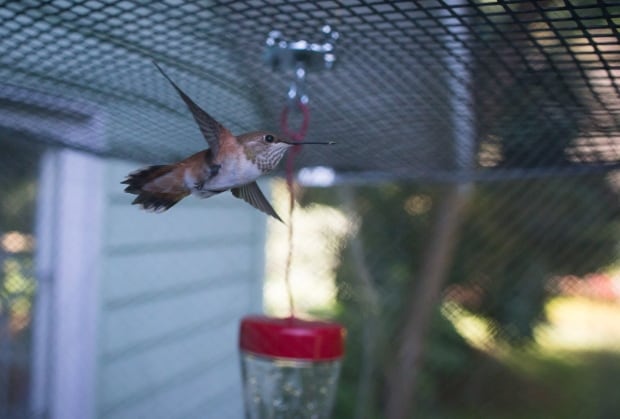Hummingbird Decline
"No one has ever measured pesticides in hummingbirds before. So we decided to try it. It turns out, to our surprise actually, that the birds are obviously picking up pesticides in their food, which can be nectar and also insects."
"Now what does it mean? Right now we're just understanding what the level of exposure is, and then how is it affecting the [hummingbird] population."
Christine Bishop, biologist, Environment and Climate Change Canada

Christine Bishop, a research scientist with Environment
and Climate Change Canada, holds a rufous juvenile male hummingbird as
she prepares to measure and band it and collect urine and feces for
testing, in Surrey, B.C. (Darryl Dyck/Canadian Press)
And the method these researchers decided to rely upon from which to extract their data is the collection of urine and feces from the hummingbirds. That collection and the resulting data appear to confirm that the concentration of pesticides in hummingbird urine is fairly high, at three parts per billion. The study focused on the Fraser Valley and southern British Columbia, those agricultural regions identified as a core locale for the rufous hummingbird.
The tiny bird with a red throat has a negligible weight, roughly that of a five-cent piece. It spends its summers in British Columbia, in Alaska and the Pacific Northwest states. When signs of winter arriving alert the hummingbird to its survival imperative by reverting to its species' habitual migration, it returns to the southern United States and Mexico which represent its winter habitation site, away from the bitter cold of the summer location.

A rufous juvenile male hummingbird flies around after being captured with a net above a feeder. (Darryl Dyck/Canadian Press)
Hummingbirds, like bees, habitually come back to routinely recognized places to find their food, recalling where certain flowers grow. Another concern is that pesticide absorption might have the effect of disrupting their memory. According to an annual breeding bird survey, between 1966 and 2013, the population on the Pacific Coast of the rufous hummingbird has declined an average of 2.67 percent annually.
Two other species of hummingbird were also found to be in decline, the Allen's and broad-tailed hummingbirds, leading Health Canada to reevaluate the use of imidacloprid, a neonicotinoid insecticides commonly used on agricultural crops and coincidentally used as well for flea and tick control on cats and dogs. Separately, an earlier Health Canada report noted that imidacloprid has the potential to exact short- and long-term effects on bees inclusive of behavioral changes and mortality rates.
Aside from suspicions about the effect of these insecticides there are additional issues which may be impacting on the well-being of both hummingbirds and bees. Habitat loss, seasonal plants blooming at a different time of season, even an increase in the deer population, consuming the same flowers required by the hummingbirds to exist, could all be found to play a role in the decline of these wonderful, tiny birds.

Hummingbirds filling up for their winter migration flight. (Grouse Mountain)
Labels: Agriculture, Biodiversity, Bioscience, Birds, Pesticides, Research

0 Comments:
Post a Comment
<< Home